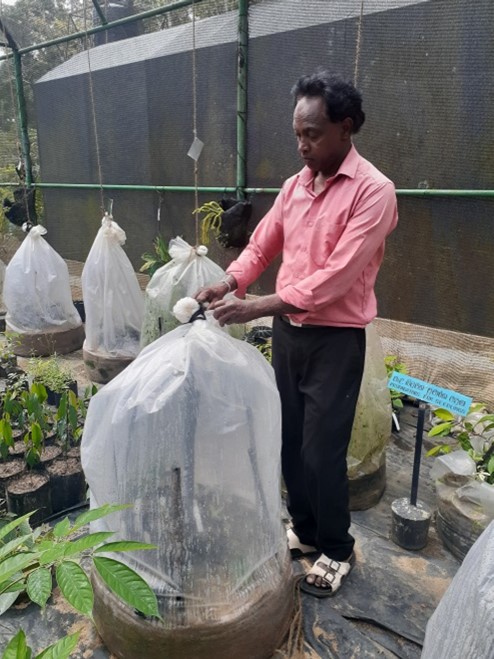Genetic diversity and seed germination studies on endangered Diospyros species, Sri Lanka

-
Status of project
Completed -
Region
Asia -
Country
Sri Lanka -
Programme
BGCI -
Workstream
Saving Plants -
Topic
Services for Botanic Gardens
Funded via the Global Botanic Garden Fund by The Botanist
Project Completed: 2023
Institution: Department of National Botanic Gardens, Peradeniya
Genetic diversity and seed germination studies on two selected species of the genus Diospyros (Ebony).
Diospyros koenigii and Diospyros atrata are two endangered endemic species in Sri Lanka. D. koenigii, was last observed in 1974 in the Gannoruwa jungle behind Peradeniya. It is also one of the most threatened (critically endangered) species, restricted to the region surrounding Kandy. D. atrata, was last observed in 1853 and is only known to exist in the same area, at Gannoruwa. These two species are on the brink of extinction, so it is crucial to manage and conserve these species, by preserving the greatest amount of genetic diversity.
Little is known about genetic diversity of Diospyros in Sri Lanka, so the first objective of this project was to understand the genetic diversity using genetic (SSR) markers of the individuals/populations, collected through adequate botanical surveys. The 16 selected SSR markers were selected based on previous studies.

Field surveys were conducted to find extant D. koenigii and D. atrata populations/individuals in Kandy district and surrounding areas with similar climatic and floristic compositions. Silica-dried leaf material was collected as well as samples for herbarium specimens. The survey enabled the team to botanically recognize 6 mature individuals of D. atrata from 3 locations and 18 individuals of D. koenigii from 6 locations. All the recorded samples of D. atrata were female as no male plant was found. Nine individuals of Diospyros koenigii (50%) were female and only one mature male plant was recorded.

Genomic DNA was extracted from leaf tissue using an improved Cetyltrimethylammonium Bromide (modified CTAB) method and the quality assessed using 1% agarose gel electrophoresis. DNA extractions were successfully achieved with the protocol.
It has been observed that both species set seeds in small numbers per tree, but studies on seed germination are not available. Therefore the next part of this project was aimed at understanding seed dormancy and optimal seed germination conditions.

There was a considerable variation in the timing of flowering and fruiting – both among and within the populations. 23 field visits were carried out throughout 2023. The flowers and fruits were monitored at various maturity stages, including at the arboretum of RBG Peradeniya. There was a considerable delay in fruit maturity and the production of viable seeds was very low in both species.
Some of the plants of D. atrata as well as in D. koenigii were not flowering during the period of observation (October 2022 to 2023 December). However, few viable seeds of D. koenigii and D. atrata were collected from seed-bearing trees in the localities. Based on these observations it was assumed that some of the female plants may have occasionally produced viable pollen, thereby self-pollinated flowers eventually produce fruits with viable seeds.

Germination tests were carried out, with a room temperature that varied from 25 degrees ± 1-2. Germination tests for all treatments were performed between moistened layers of filter paper. Dormancy breaking treatments were also used. Not all the germination attempts were successful so alternative methods of propagation were tried, such as embryo culture and propagation with stem cuttings. Further research will be conducted before setting up proper recovery planning of the species in the Botanic Gardens in Sri Lanka.
Propagation results:
>Embryo culture: Embryos of 10 seeds were used. First signs of success have emerged as development of one embryo out of 10 was observed;
>Stem cuttings: Various stages have been used. For both species, cuttings were coated with root-promoting agents and placed in three distinct media, and these were successful.
During the explorations, two juvenile plants of D. koenigii were found in a home garden in addition to an older mature tree. One of these young plants was removed through root ball method and re-established inside Botanic Garden Premises (with consent of the land owners) to ensure effective conservation of the plant.